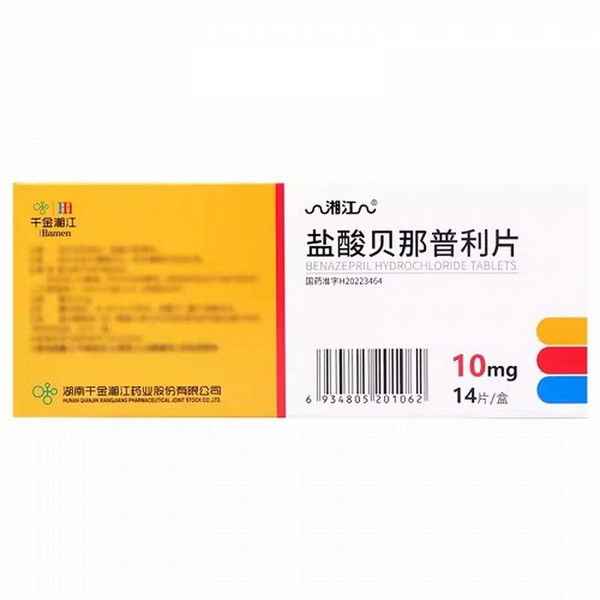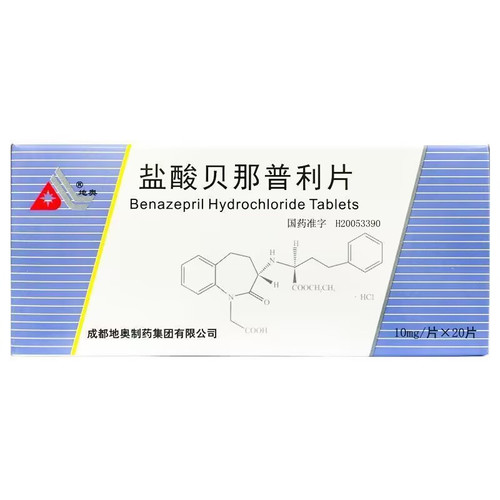Product Overview
[Drug Name]
Generic Name: Benazepril Hydrochloride Tablets
Trade Name: Xiangjiang Benazepril Hydrochloride Tablets 10mg*14 Tablets
Pinyin Code: XiangJiang YanSuanBeiNaPuLiPian 10mg*14 Tablets
[Main Ingredients]
Active ingredient: Benazepril hydrochloride Chemical name: 3-([(1-ethoxycarbonyl)-3-phenyl-(1S)-propyl]amino}-2,3,4,5-tetrahydro-2-oxo-1-hydro-1-(3S)-benzazepine-1-acetic acid monohydrochloride
Molecular formula of salt: C24H28N2O5·HCl Molecular Weight: 460.96
[Properties]
This product is a film-coated tablet that appears white after removal of the film coating.
[Indications/Main Functions]
For the treatment of hypertension and congestive heart failure. As an adjunctive treatment for patients with congestive heart failure (NYHA Class I-IV) who have an inadequate response to digitalis and/or diuretics.
[Specifications]
10mg*14 tablets
[Dosage and Administration]
Hypertension: For patients not taking diuretics, the recommended initial daily dose is 10mg once daily. If response is inadequate, the dose can be increased to 20mg daily. The dose should be adjusted based on blood pressure response, typically every 1 to 2 weeks. For some patients, at the end of the dosing interval, During the initial treatment period, the antihypertensive effect may be weakened. For such patients, the total daily dose should be divided into two doses, or a diuretic should be added. The maximum recommended daily dose of this product for the treatment of hypertension is 40 mg, taken once or divided into two doses. If the blood pressure reduction achieved with this product alone is not satisfactory, another antihypertensive drug, such as a thiazide diuretic, calcium antagonist, or beta-blocker, can be added (starting with a low dose). For patients who have previously been treated with diuretics, especially those with excessive sodium and/or fluid losses, the dosing schedule or dose reduction should be carefully considered when starting this product. This includes reducing or suspending the diuretic for a period of time (e.g., 2-3 days) before starting Lotensin® treatment, or For patients with congestive heart failure, reduce the starting dose of Lotensin to 5 mg to avoid hypotension (see [Precautions]). Fluid and/or sodium depletion should be corrected before starting treatment with this product. Patients with creatinine clearance ≥30 ml/min can take the usual dose. For patients with creatinine clearance <30 ml/min, the initial daily dose is 5 mg, which can be increased to 10 mg/day if necessary. If further blood pressure reduction is required, a diuretic or another antihypertensive drug can be added. Congestive Heart Failure: This product is indicated for adjunctive treatment of patients with congestive heart failure. The recommended initial dose is 2.5 mg (5 mg, half a tablet) once daily. Due to the risk of a sharp drop in blood pressure after the first dose, Patients should be closely monitored when first taking this drug (see [Precautions]). If heart failure symptoms are not effectively relieved, the dose can be increased to 5 mg once daily after 2-4 weeks, provided the patient does not experience symptomatic hypotension or other unacceptable side effects. Depending on the patient's clinical response, the dose can be increased to 10 mg once daily or even 20 mg once daily at appropriate intervals. This drug is effective with a single daily dose. However, some patients may respond better if the daily dose is divided into two doses. Controlled clinical studies have shown that patients with severe heart failure (NYHA class IV) require lower doses than those with mild or moderate heart failure (NYHA class II-I). For patients currently receiving diuretics, particularly those with excessive sodium and/or fluid depletion, caution is advised when adding this drug, and specialized monitoring is recommended. Depending on the clinical situation, it may be necessary to consider reducing or temporarily discontinuing diuretic therapy before initiating this drug. Correction of blood volume and/or sodium depletion should be performed before initiating this drug. When the creatinine clearance in patients with heart failure is less than 30 m/min, the daily dose can be increased to a maximum of 10 mg, but a lower initial dose [e.g., 2.5 mg (5 mg, half a tablet)] may be more ideal. Progressive chronic renal insufficiency (CRI): For patients with progressive CRI with or without hypertension, the recommended long-term dose is 10 mg once daily. If additional treatment is required to further lower blood pressure, it can be used in combination with other antihypertensive drugs.
[Adverse Reactions]
See the package insert for details.
[Contraindications]
· Known hypersensitivity to benazepril, related compounds, or any of the excipients of this product. · Patients with a history of angioedema caused by or not caused by angiotensin-converting enzyme inhibitors. · Pregnancy (see [Use in Pregnant and Lactating Women]). · In patients with type 1 diabetes, ACE inhibitors (including this product) or angiotensin receptor blockers (ARBs) should be used concomitantly with aliskiren (see [Drug Interactions]). Concomitant use of ACE inhibitors (including this product) with neprilysin inhibitors (e.g., sacubitril). This product should not be taken within 36 hours before starting treatment with sacubitril-valsartan sodium tablets (a drug with neprilysin inhibitory properties) or within 36 hours after stopping sacubitril-valsartan sodium tablets (see [Precautions] and[Drug Interactions]).
[Precautions]
See the package insert for details.








